Preliminary work on parameters to explore regimes in ABC model
- Calling the model “ABC model” as the parameters are A, B and C.
- A: pure gravity wave frequency.
- B: advection term modification for control of acoustic wave speed.
- C: used in simplified equation of state, p̃’ = Cρ’ ⁄ ρ0.
Reminder of equations
(∂u)/(∂t) + Bu⋅∇u + C(∂ρ̃’)/(∂x) − fv
=
0,
(∂v)/(∂t) + Bu⋅∇v + fu
=
0,
(∂w)/(∂t) + Bu⋅∇w + C(∂ρ̃’)/(∂z) − b’
=
0,
(∂ρ̃’)/(∂t) + B∇⋅(ρ̃u)
=
0,
(∂b’)/(∂t) + Bu⋅∇b’ + A2w
=
0.
Scaling the equations
The following scalings are used:
- u has characteristic value U, leading to u = Uu*.
- v has characteristic value V, leading to v = Vv*.
- w has characteristic value W, leading to w = Ww*.
- ρ̃’ has characteristic value P’, leading to ρ̃’ = P’ρ̃’*.
- ρ̃ has characteristic value P, leading to ρ̃ = Pρ̃*.
- b’ has characteristic value ℬ, leading to b’ = ℬ’b’*.
- Characteristic horizontal lengthscale ℒ, which is derived from the ρ̃’ field, leading to x = ℒx*.
- Characteristic vertical lengthscale ℋ, which is derived from the ρ̃’ field, leading to z = ℋz*.
- Characteristic timescale ℒ ⁄ U, leading to t = ℒ ⁄ Ut*.
Note that we do not use the (otherwise) standard W ~ Uℋ ⁄ ℒ as this is only valid for incompressible flows. Also, it is necessary that u and v are scaled separately.
The following dimensionless numbers are used:
- Rossby number Ro = U ⁄ (fℒ).
- Mach number M = U ⁄ √(BC).
- Froude number Fr = U ⁄ √(gℋ).
- Aspect ratio Ar = ℋ ⁄ ℒ.
- Vertical to horizontal wind ratio Aw = W ⁄ U.
- Au = U ⁄ V.
The scaled equations are as follows:
RoM2Au⎡⎣(∂u*)/(∂t*) + Bu*(∂u*)/(∂x*) + BF2rAw(gℒ)/(U2)w*(∂u*)/(∂z*)⎤⎦ + RoAu(P’)/(B)(∂ρ̃’*)/(∂x*) − v*
=
0,
Ro⎡⎣(∂v*)/(∂t*) + Bu*(∂v*)/(∂x*) + B(Aw)/(Ar)w*(∂v*)/(∂z*)⎤⎦ + Auu*
=
0,
Ro⎡⎣(∂w*)/(∂t*) + Bu*(∂w*)/(∂x*) + (gℒ)/(U2)F2rAww*(∂w*)/(∂z*) + (P’)/(B)(1)/(AwAr)(1)/(M2)(∂ρ̃’*)/(∂z*)⎤⎦ − (ℬ’)/(fW)b’*
=
0,
( P’)/(P)(∂ρ̃’*)/(∂t*) + B(∂(ρ̃*u*))/(∂x*) + B(Aw)/(Ar)(∂(ρ̃*w*))/(∂z*)
=
0,
Ro⎡⎣(∂b’*)/(∂t*) + Bu*(∂b’*)/(∂x*) + B(Aw)/(Ar)w*(∂b’*)/(∂z*)⎤⎦ + (A2 W)/(ℬ’f)w*
=
0.
The factors are labeled as, e.g. w4 is the fourth scaling factor of the w equation, i.e. Ro(P’)/(B)(1)/(AwAr)(1)/(M2).
Experiments
The following experiments have been done to investigate regimes.
- The experiment numbers in red are just for my reference.
- The fields at t = 3 hours are used to generate the above characteristic values.
- The experiments differ from the control by the value of the parameters A, B, C or f.
- The lengthscales are found from the following formula len = (1)/(2)∫[dk |(k)|2 ⁄ k] ⁄ ∫[dk |(k)|2] (where (k) is the Fourier transform in either the horizontal or vertical, and where len is either ℒ or ℋ).
- Comparisons of each experiment are made against the control.
- Not all of the scaling factors are given in this document - see spreadsheet for all diagnostics.
- Remarks written in green denote unexpected or apparently contradictory results.
Experiment 1 (00) - control parameters
A = 2 × 10 − 2, B = 10 − 2, C = 105, f = 10 − 4.
Longitude-height screenshots of geostrophic and hydrostatic imbalance.
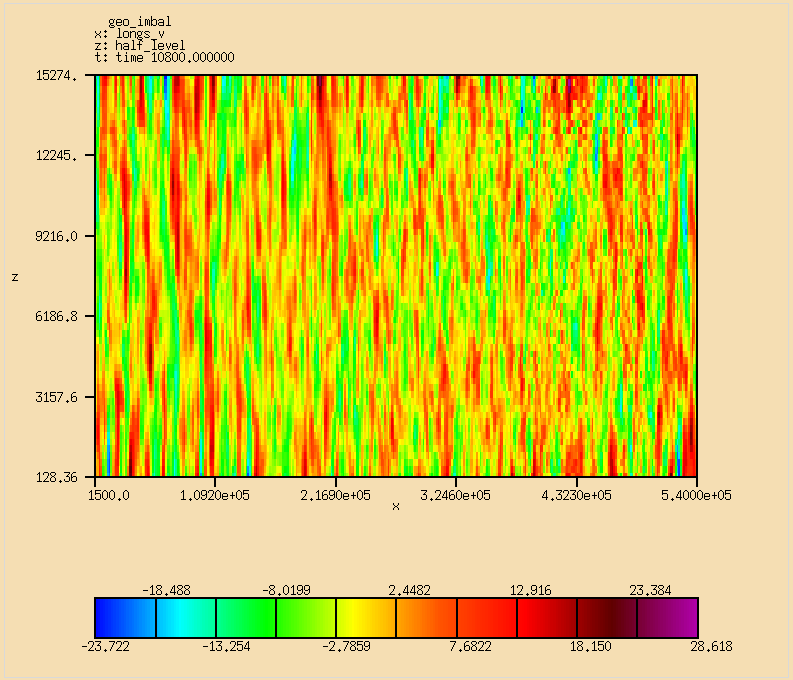
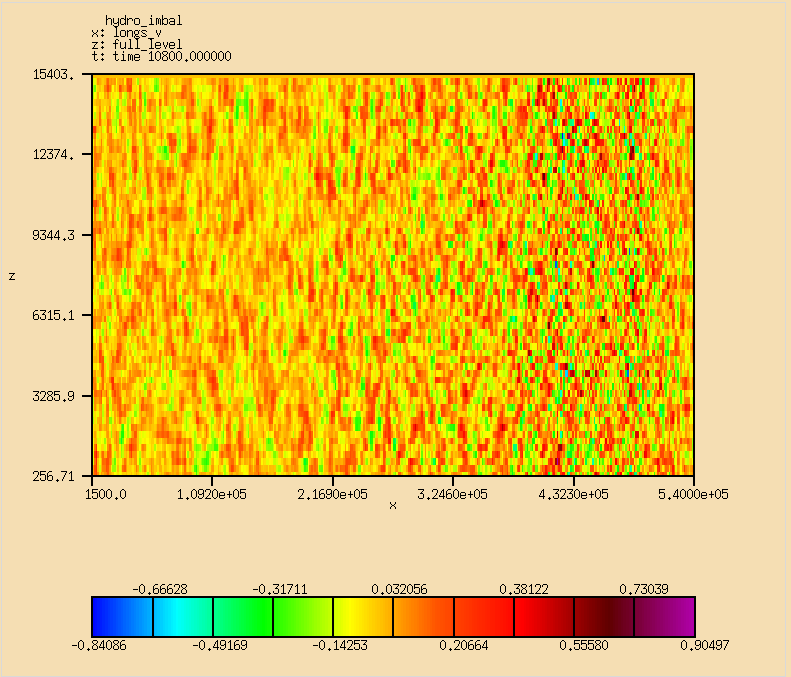
Experiment 2 (05) - decrease A in attempt to make the system more convective
A = 2 × 10 − 4, B = 10 − 2, C = 105, f = 10 − 4.
Longitude-height screenshots of geostrophic and hydrostatic imbalance.
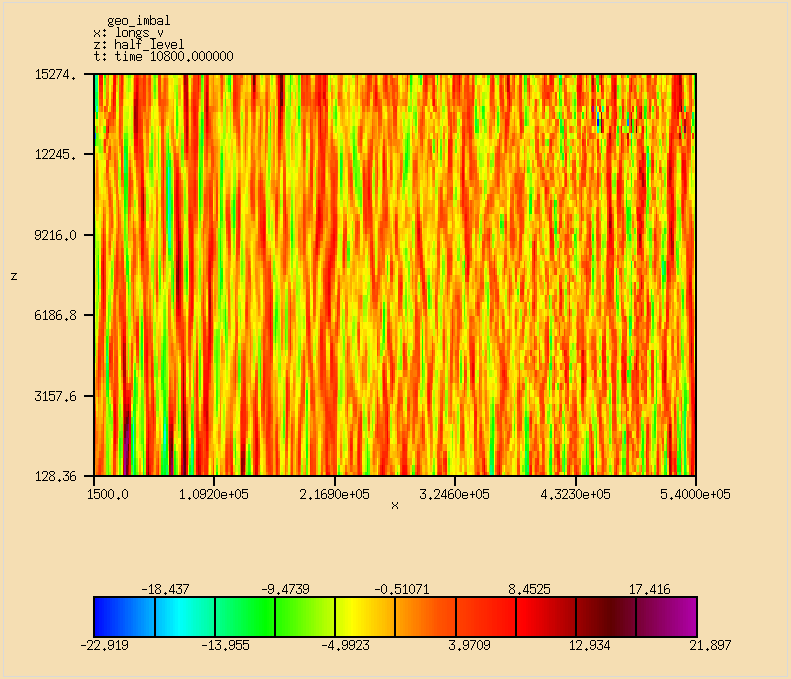
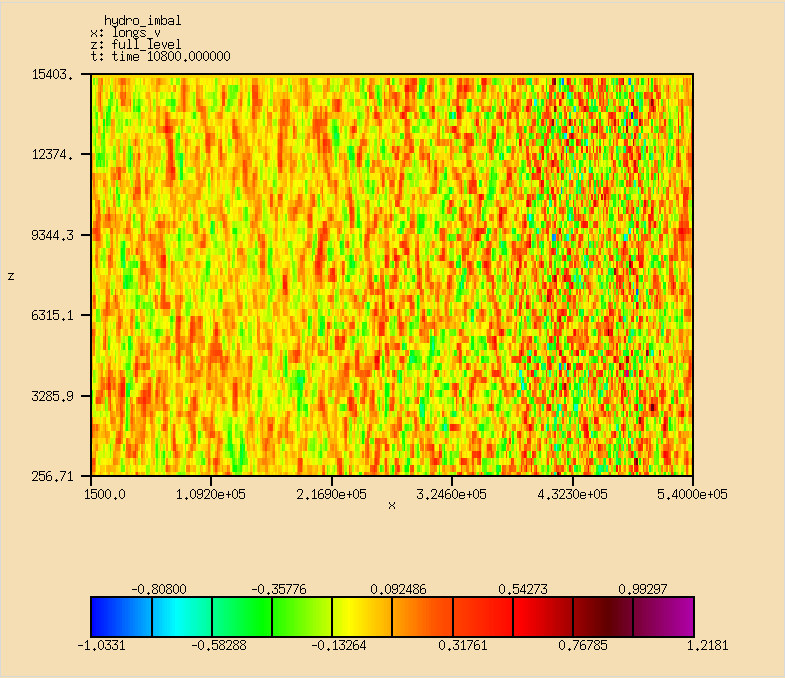
This does increase W by a factor of 30 (Fig. 3) and increase ℋ slightly (Fig. 2). w4and w5 together dominate the w-equation less so (Fig. 4), but is only slightly less hydrostatic (above diagnostic).
Experiment 3 (17) - increase C in an attempt to make the system more incompressible
A = 2 × 10 − 2, B = 10 − 2, C = 107, f = 10 − 4.
Longitude-height screenshots of geostrophic and hydrostatic imbalance.
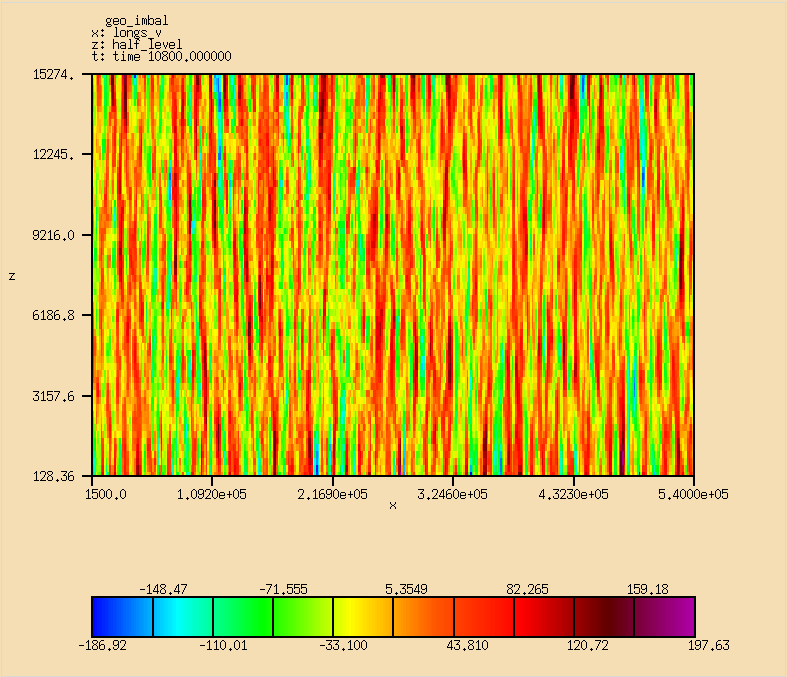
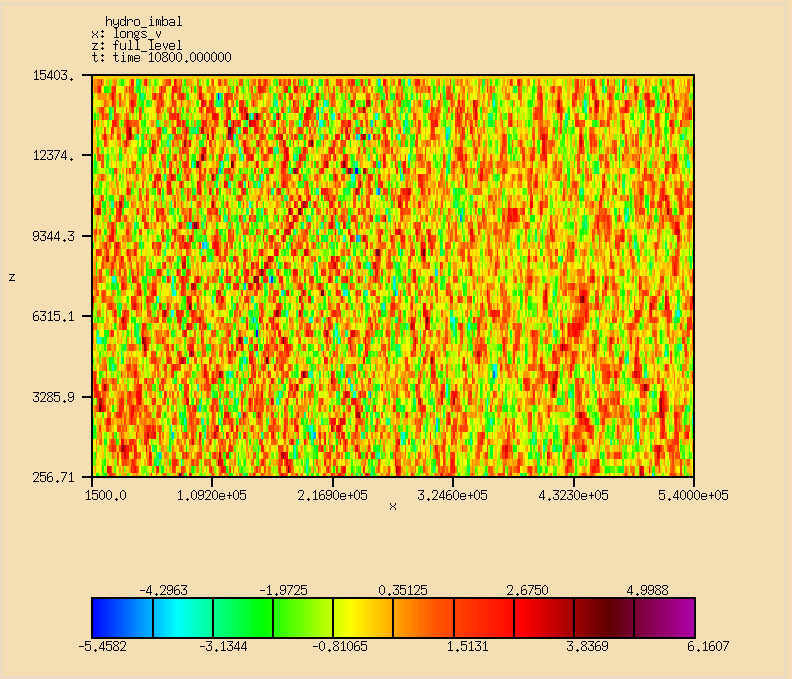
Increasing C increases the acoustic wave speed and weight ρ’1 takes a lower share of the weight for this experiment (Fig. 4). The system gets a lot less balanced (above diagnostics), which is seen - perhaps - in the lower u4 weight in Fig. 4 (for geostrophic balance), and slightly increased Ro (Fig. 1). Was expecting this situation to be more hydrostatically balanced due to larger acoustic wave speed. The weights w4 and w5 in Fig. 4 for this experiment do not suggest a strong change in hydrostatic balance.
Experiment 4 (15) - decrease C in an attempt to make the system more compressible
A = 2 × 10 − 2, B = 10 − 2, C = 102, f = 10 − 4.
Longitude-height screenshots of geostrophic and hydrostatic imbalance.
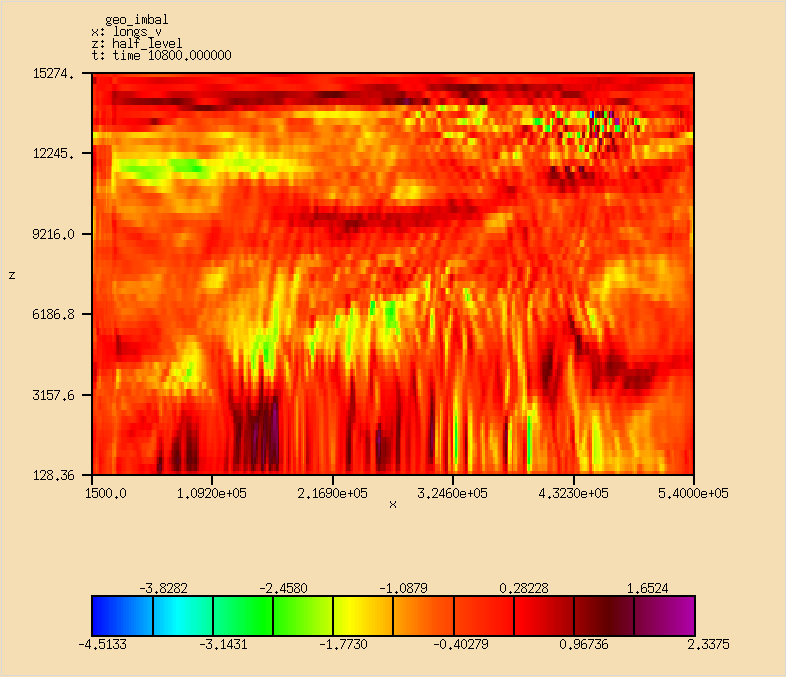
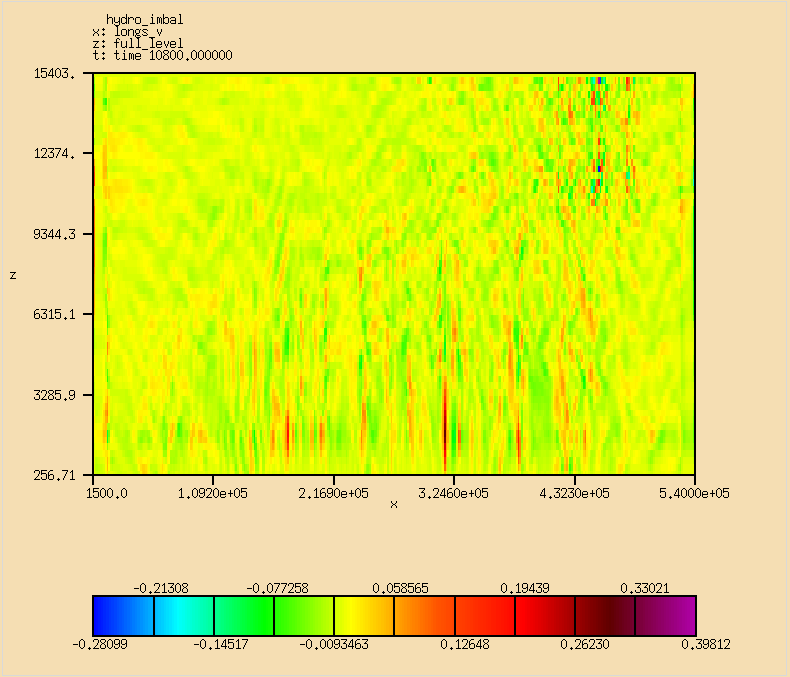
Decreasing C decreases the acoustic wave speed and weight ρ’1 dominates the weight for this experiment (Fig. 4). The system gets more balanced (above diagnostics), and slightly decreased Ro (Fig. 1). The u weights (Fig. 4) give unclear results for geostrophic balance. The w weights (Fig. 4) give consistent results with increased hydrostatic balance. Was expecting this situation to be less hydrostatically balanced due to smaller acoustic wave speed. Why does the geostrophic imbalance look more horizontal and the hydrostatic imbalance look more vertical?
Experiment 5 (08) - increase B in an attempt to make the system more incompressible
A = 2 × 10 − 2, B = 1, C = 105, f = 10 − 4.
Longitude-height screenshots of geostrophic and hydrostatic imbalance.
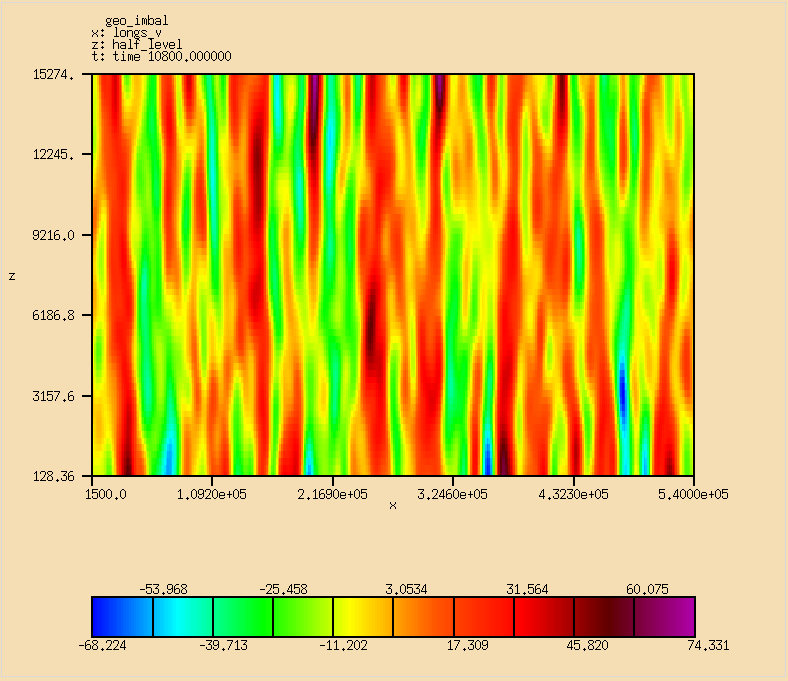
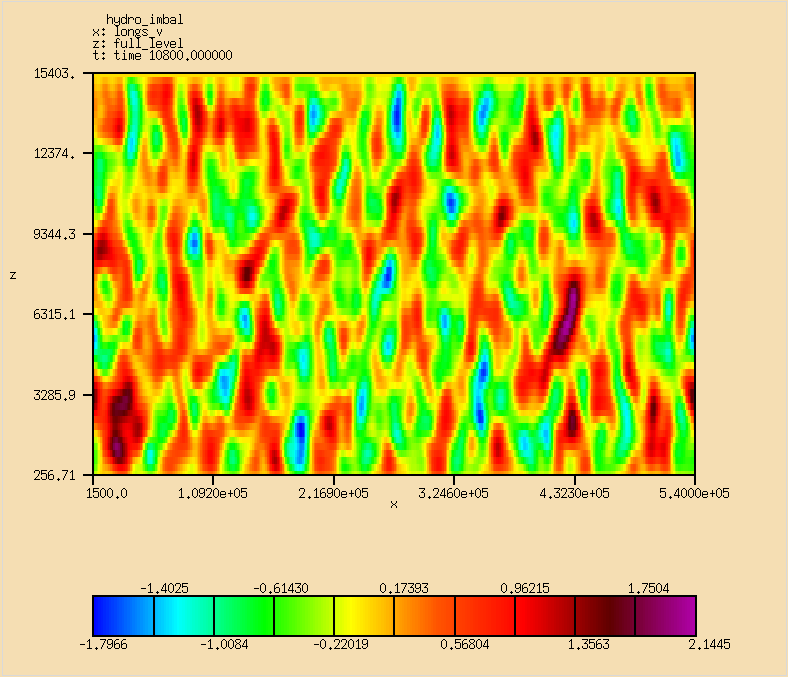
Increasing B increases the acoustic wave speed and weight ρ’1 takes a lower share of the weight for this experiment (Fig. 4). The system gets a lot less balanced (above diagnostics), which is seen in the u weights in Fig. 4 (for geostrophic balance) and in weight w2 in Fig. 4. Ro is increase slightly (Fig. 1). Was expecting this situation to be more hydrostatically balanced due to larger acoustic wave speed. Why are the vertical ’strips’ broader in the geostrophic imbalance and the ’blobs’ larger in the hydrostatic imbalance? Larger acoustic wave speed?
Experiment 6 (11) - decrease B in an attempt to make the system more compressible
A = 2 × 10 − 2, B = 10 − 4, C = 105, f = 10 − 4.
Longitude-height screenshots of geostrophic and hydrostatic imbalance.
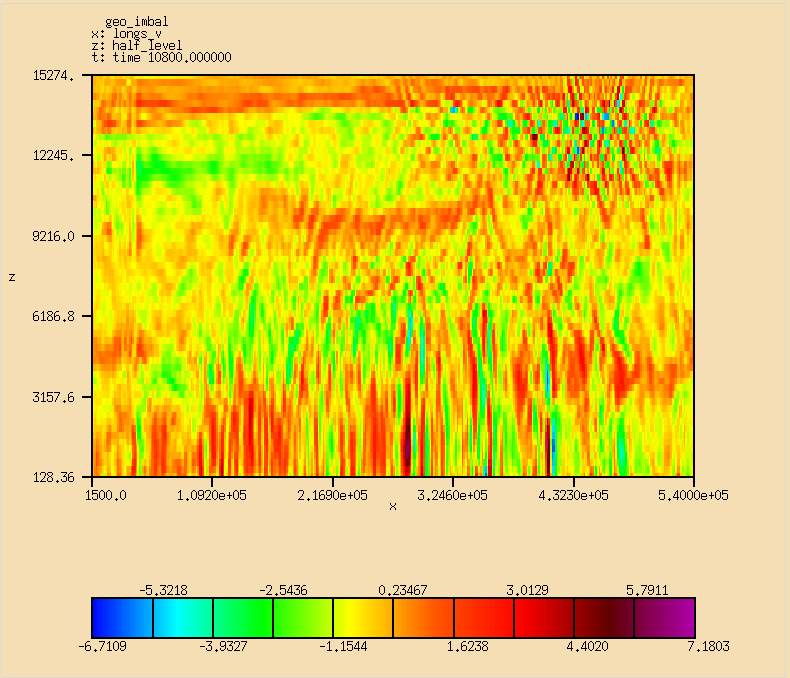
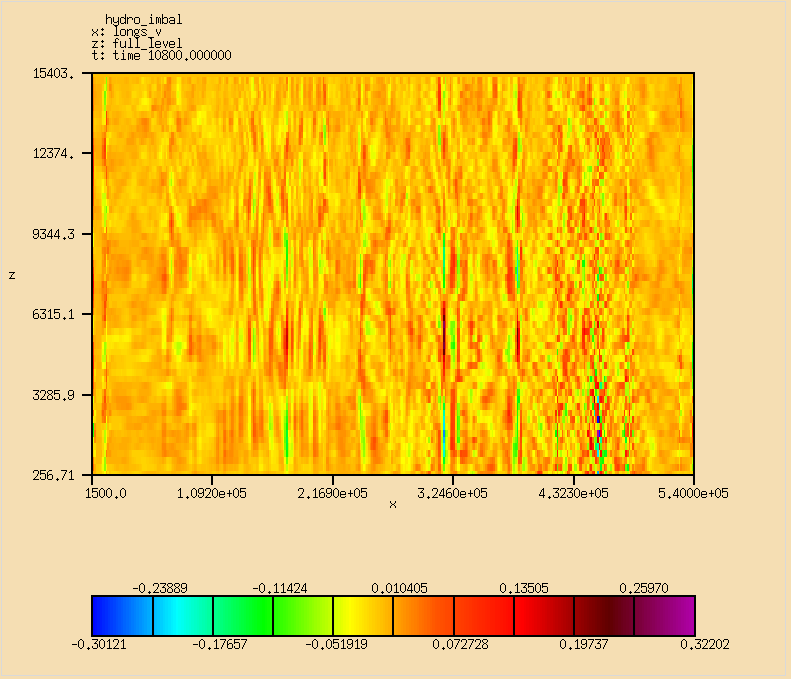
Decreasing B decreases the acoustic wave speed and weight ρ’1 dominates the weight for this experiment (Fig. 4). The system gets more balanced (above diagnostics). The u weights (Fig. 4) give unclear results for geostrophic balance. The w weights (Fig. 4) give consistent - but subtle - results with increased hydrostatic balance. Ro is lower (Fig. 1). Was expecting this situation to be less hydrostatically balanced due to smaller acoustic wave speed. Why does the geostrophic imbalance look more horizontal and the hydrostatic imbalance look more vertical? This is similar to Exp. 4.
Experiment 7 (23) - increase f in an attempt to make the system more balanced
A = 2 × 10 − 2, B = 10 − 2, C = 105, f = 10 − 2.
Longitude-height screenshots of geostrophic and hydrostatic imbalance.
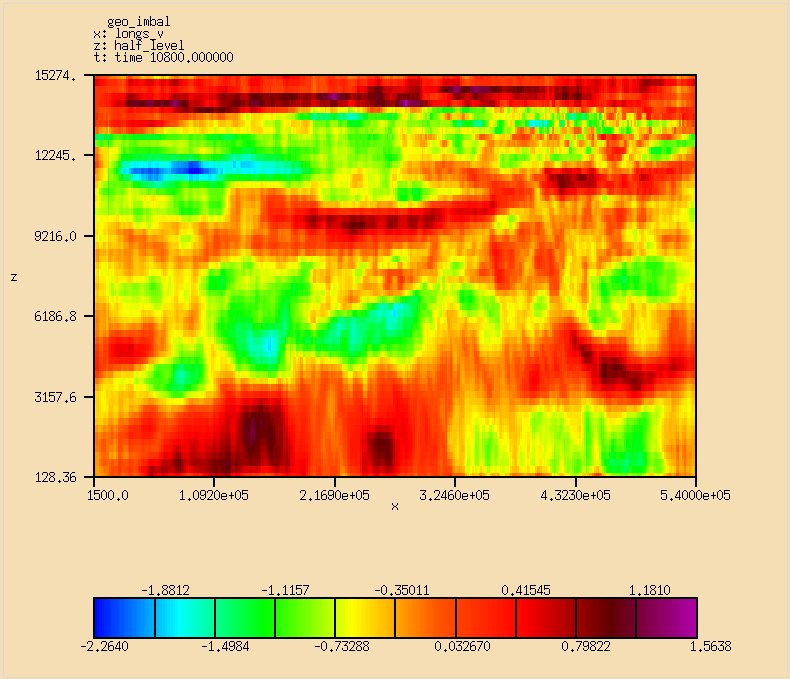
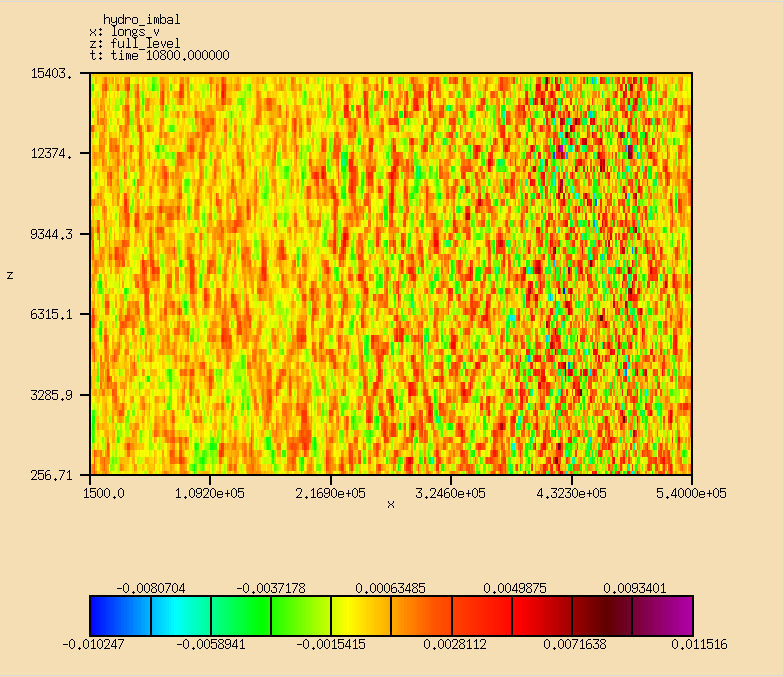
Increasing f increases balance hugely (above diagnostics). Weights u1, u2 and u3 take on smaller proportions and similarly for w1, w2 and w3 (Fig. 4). Ro is smaller (Fig. 1). Allows more vertical wind (Fig. 3).
Experiment 8 (20) - decrease f in an attempt to make the system less balanced
A = 2 × 10 − 2, B = 10 − 2, C = 105, f = 10 − 6.
Longitude-height screenshots of geostrophic and hydrostatic imbalance.
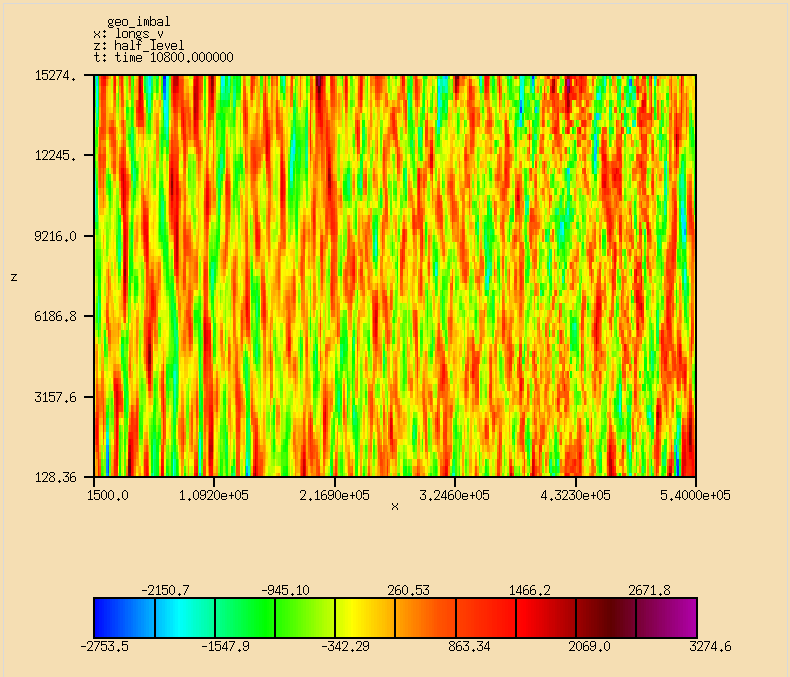
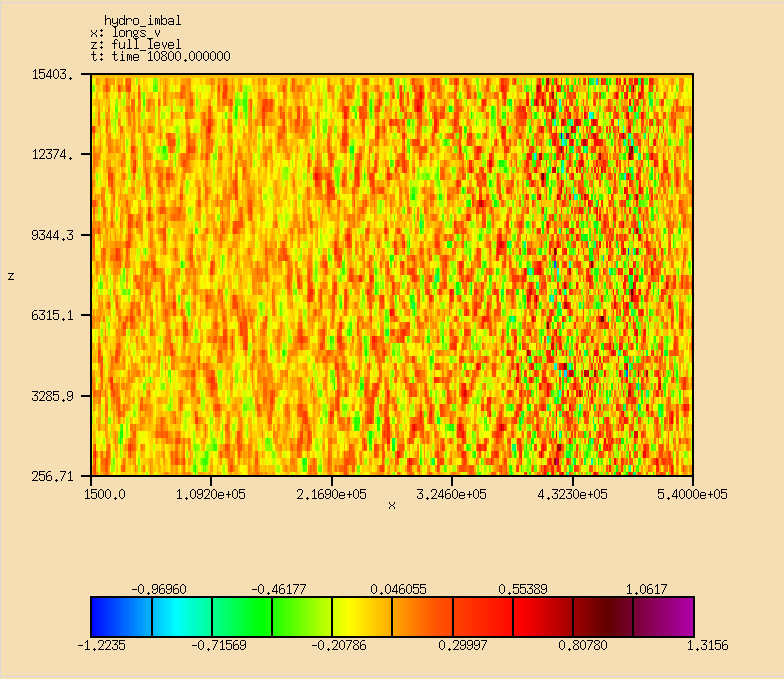
Decreasing f increases imbalance hugely (above diagnostics). Weights u1, u2 and u3 take on larger proportions and similarly (possibly) for w1, w2 and w3 (Fig. 4). Ro is larger (Fig. 1). Less vertical wind (Fig. 3).
Experiment 9 (32) - mixture of Exps. 3 and 6 (to offset each other)
A = 2 × 10 − 2, B = 10 − 4, C = 107, f = 10 − 6.
Longitude-height screenshots of geostrophic and hydrostatic imbalance.
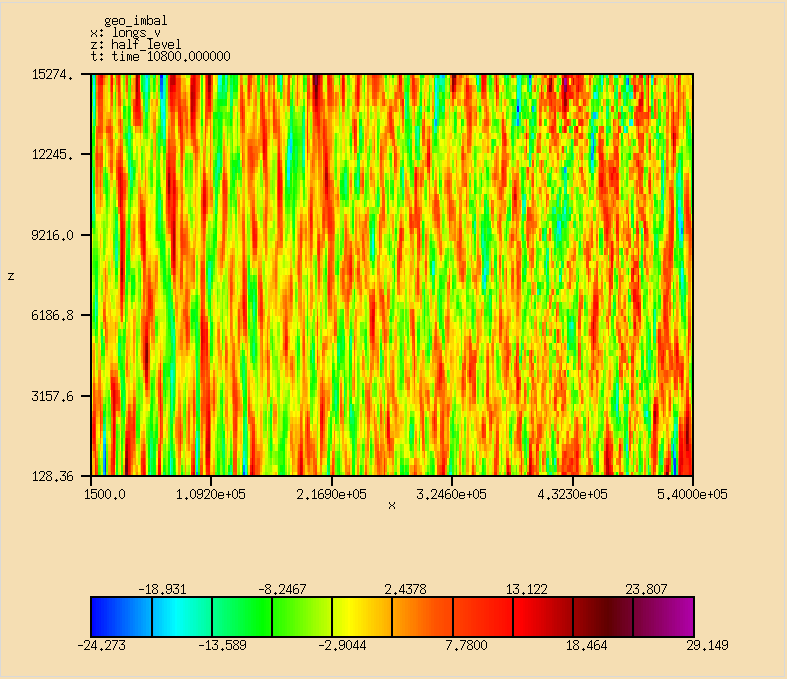
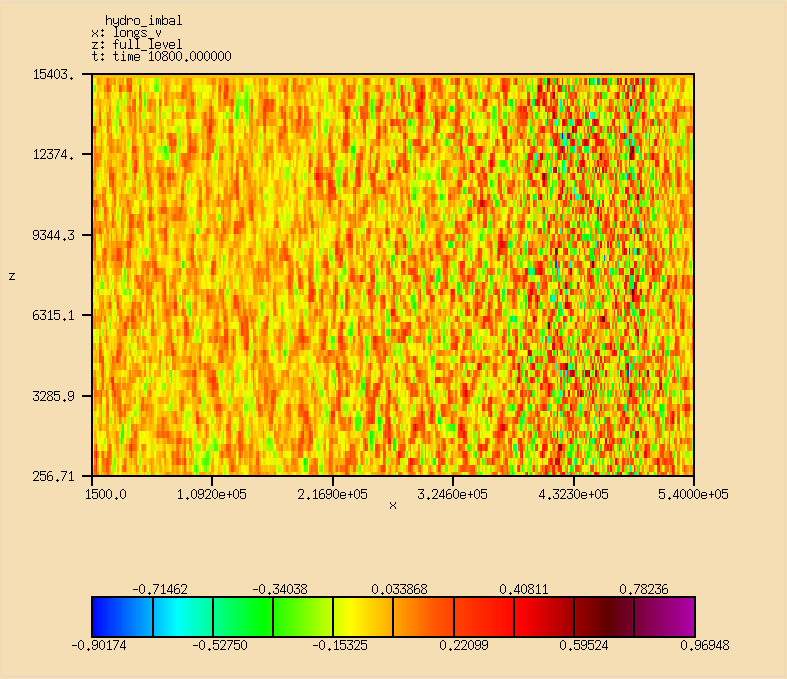
The balance properties are very similar to those of the control parameters (the acoustic and gravity wave speeds are unchanged). The weights ρ’1, ρ’2 and ρ’3 are all an order of magnitude lower than the control, suggesting that the compressibility is largely unaffected.
Fig. 1: Rossby, Mach and Froude numbers for these experiments
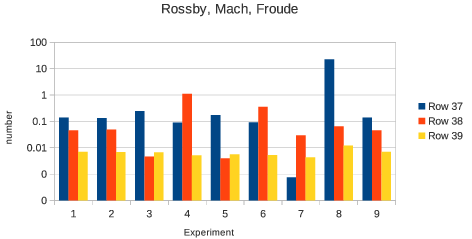
Fig. 2: Horizontal and vertical lengthscales for these experiments
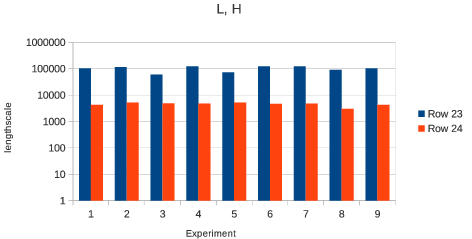
Fig. 3: Aspect ratios and vertical to horizontal wind ratios for these experiments
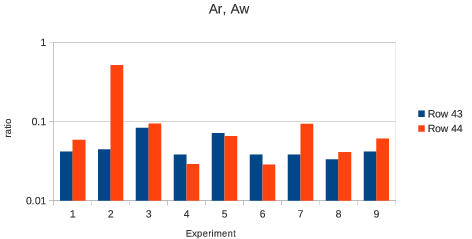
Fig. 4: Weights for the scaled equations
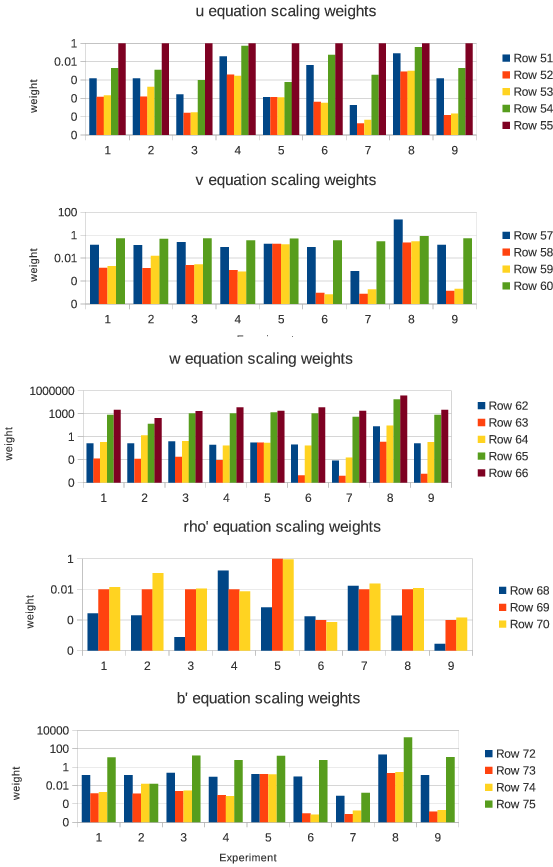
Next steps
I would suggest taking the following regimes:
- Control regime: Exp. 1.
- Incompressible regimes: Exps. 3 and 5.
- Offset regime: Exp 9.
- Unbalanced regime: Exp. 8.
- Convective regime: Use Exp. 2 or 3/5?